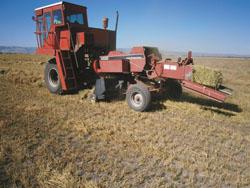 “My son and I built a self-propelled baler using the frame, motor and cab from a 1980’s model Massey 550 combine,” says Howard Elmer, a Cove, Ore., farmer. “We tried building one using an old Hesston swather a few years ago, but the frame wasn’t strong enough and the engine didn’t have enough power. This machine has a 354 Perkins motor with a hydrostatic drive, so we have plenty of power.”
“My son and I built a self-propelled baler using the frame, motor and cab from a 1980’s model Massey 550 combine,” says Howard Elmer, a Cove, Ore., farmer. “We tried building one using an old Hesston swather a few years ago, but the frame wasn’t strong enough and the engine didn’t have enough power. This machine has a 354 Perkins motor with a hydrostatic drive, so we have plenty of power.”
Howard and his son, Sage, removed the grain tank, threshing unit, feederhouse and gas tank from the old Massey. They kept the engine, drive train and cab in place, including an old air conditioning unit that they mounted behind the cab. They replaced the combine’s gas tank with one from a D-4 Cat and mounted it under the cab.
They cut the combine frame off behind the cab because they wanted a true self-propelled baler rather than just a combine drive train pulling the baler like a tractor. Then they removed the baler’s stationary wheels and replaced them with the combine’s oscillating steering wheels. Elmer says this modification allows the re-built machine to have power steering and turn just like the old self propelled combine.
The Elmers connected the two machines together with a sub frame they built using 5- in. channel iron. They cut 3 ft. off the tongue of their IHC 4650 inline baler and mated the two implements together using diagonal bracing at the connection point. They also reinforced the baler hitch by adding 5/8 by 5-in. pieces of flat bar.
The combine engine powers the baler through a right angle gearbox that connects the combine’s old cylinder shaft to the baler pto shaft. Howard says they salvaged pulleys from another Massey combine to convert the 700 rpm cylinder speed on the combine drive shaft to about 520 rpm for driving the baler. “Running the baler a little slower than 540 rpm’s doesn’t affect its operation at all. I can compensate for the slower baler speed by easily adjusting the ground speed with the hydrostatic drive,” Howard says.
The Elmers have two other inline balers and say this homebuilt rig has about the same capacity as their other machines pulled by tractors. “We’ve had all three machines in the same field and they run almost identical across the field,” Howard says. “I can turn corners faster because the hydrostatic drive lets me speed up at the ends while the tractors are in a fixed gear.”
Howard says the old combine cab sitting right over the drive wheels provides excellent visibility above a windrow, but he needs to add a video camera that shows him how the baler is working. “I can see the top of the knotters and see the bales drop, but watching the hay feed in would make it easier to adjust my ground speed.”
The machine’s 138-in. wheelbase is shorter than a tractor pulling a baler, and its turning radius is about the same as a combine. The baler has about 4 in. of added ground clearance because of the new wheels, but that hasn’t affected how hay feeds in or how the bales drop. The 3-speed combine transmission allows them to bale at about 2 to 3 mph in first gear and travel down the road at 12 to 13 mph in third gear.
Howard says the project took a lot of planning and adds “For awhile I thought we might just have a unique piece of equipment for the 4th of July parade, but eventually we got it done and even had some friendly advice from a neighbor. We’ve had a few problems with a belt slipping and some leaking oil, but now that’s fixed and it’s working great.”
1-800-834-9665
Old Combine Made Into Self-Propelled Baler
FARM SHOW Magazine » Old Combine Made Into Self-Propelled Baler
Old Combine Made Into Self-Propelled Baler
